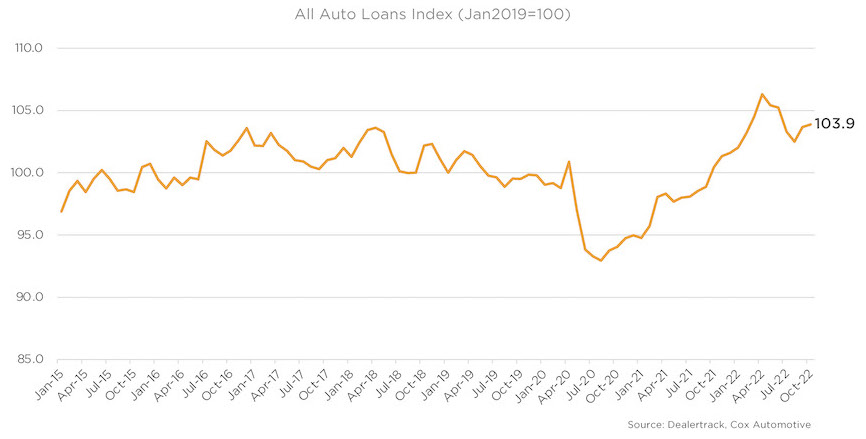Data Point
Auto Credit Availability Loosens Slightly for Second Month in a Row
Thursday November 10, 2022
Article Highlights
- Access to auto credit expanded slightly for the second consecutive month in October, according to the Dealertrack Auto Credit Availability Index for all types of auto loans.
- The All-Loans Index increased 0.2% to 103.9 in October, reflecting that auto credit was easier to get in the month compared to September.
- All loan types saw loosening in October with certified pre-owned loans loosening the most.
Access to auto credit expanded slightly for the second consecutive month in October, according to the Dealertrack Credit Availability Index for all types of auto loans. The All-Loans Index increased 0.2% to 103.9 in October, reflecting that auto credit was easier to get in the month compared to September. The improvement in access reflected conditions that were loosest since June. With the increase in October, access was looser by 3.4% year over year, and compared to February 2020, access was looser by 4.8%.
Dealertrack Credit Availability Index
Auto loan access increased slightly in October for second month in a row after prior four months saw declines

The trends in credit availability factors were mixed in October, but consumers benefited from yield spreads narrowing, subprime share increasing, and the share of loans with negative equity growing. The average yield spread on auto loans narrowed, so rates consumers saw on auto loans were more attractive in October relative to bond yields. The average auto loan rate increased by 43 basis points (BPs) in October compared to September, while the 5-year U.S. Treasury increased by 49 BPs, resulting in a narrower average observed yield spread.
The subprime share increased to 11.9% in October from 11.7% in September. The share of auto loans with negative equity also rose to the highest level since the spring of 2020.
Auto Loan Approval Rates Fell to Lowest Level Since 2020
Working against consumers in October, the approval rate fell to its lowest level since 2020, the share of loans with longer terms declined, and the down payment share increased.
Most loan types saw loosening in October, but aggregate uses and loans through independent dealers were unchanged. Certified pre-owned (CPO) loans loosened the most. On a year-over-year basis, all channels saw higher credit access, with CPO loans loosening the most.
Credit Access Loosens Across All Lender Types
Credit access loosened across all lender types in October, with banks loosening the most and auto-focused finance companies loosening the least. On a year-over-year basis, all lenders had looser standards, with auto-focused financed companies having loosened the most and credit unions having loosened the least.
Each Dealertrack Auto Credit Index tracks shifts in loan approval rates, subprime share, yield spreads and loan details, including term length, negative equity, and down payments. The index is baselined to January 2019 to show how credit access shifts over time. Across all auto lending in October, yield spreads narrowed, the subprime share increased, and the share with negative equity increased, so those factors helped access improve. The approval rate declined, terms shortened, and down payments increased, and those moves worked against credit access.
Measures of Consumer Confidence Mixed in October
The Conference Board Consumer Confidence Index® declined 4.9% in October when a smaller 1.9% decline had been expected, and the September index was also revised down. Most of the index decline was driven by a 7.5% decline in views of the present situation. Plans to purchase a vehicle in the next 6 months rebounded strongly to the highest level since July 2020 and was up substantially year over year. The confidence index has not declined as much this year as the sentiment index from the University of Michigan, but that series improved in October. The Michigan index increased by 2%, but its underlying measures moved in different directions, with views of current conditions improving and expectations declining. The daily Index of Consumer Sentiment from Morning Consult declined 2.7% in October as both underlying measures of current conditions and future expectations declined. Stock market volatility and mid-term election rhetoric likely weighed on the observed declines.
The Dealertrack Credit Availability Index is a new monthly index based on Dealertrack credit application data and will indicate whether access to auto loan credit is improving or worsening. The index will be published around the 10th of each month.
